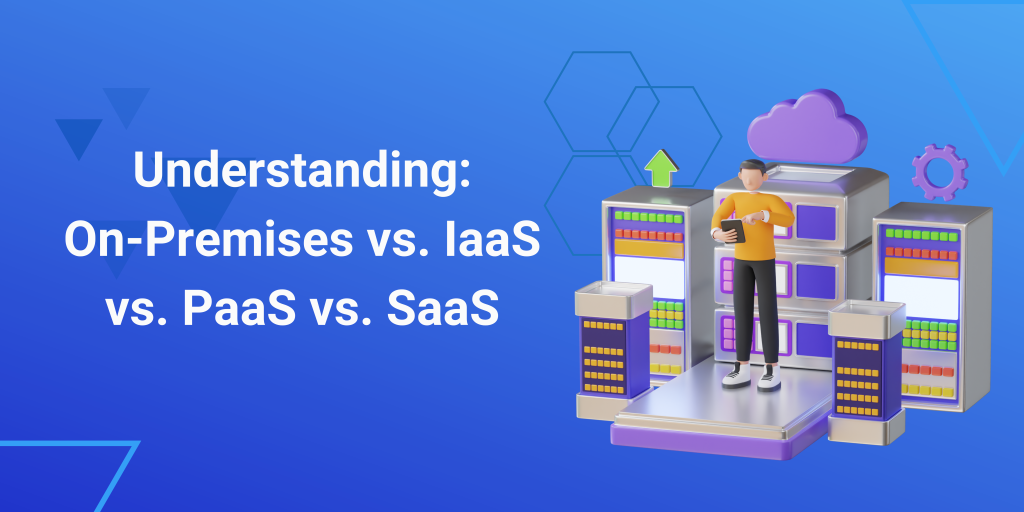On-Premises vs. IaaS vs. PaaS vs. SaaS

In the rapidly evolving world of technology, businesses are faced with crucial decisions when it comes to managing their IT infrastructure. The cloud has emerged as a transformative force, providing various deployment models to meet diverse needs. This blog aims to explore the differences between On-Premises, Infrastructure as a Service (IaaS), Platform as a Service (PaaS), and Software as a Service (SaaS), to help you make informed choices based on your organization’s requirements.
On-Premises
On-Premises solutions refer to the practice of hosting and maintaining all hardware and software within an organization’s physical location. This model gives the organization complete control over the infrastructure but requires significant upfront investments in equipment, dedicated personnel, and ongoing maintenance costs. While On-Premises solutions offer unparalleled customisation and security, they may lack the scalability and flexibility found in cloud-based alternatives.
Infrastructure as a Service (IaaS)
IaaS is a cloud computing model that allows organizations to use virtualised resources through the internet instead of investing in physical servers, storage, and networking equipment. By renting these resources from a cloud provider, businesses can take advantage of scalability, which allows them to adjust their infrastructure based on their needs. Some popular IaaS providers include Amazon Web Services (AWS), Microsoft Azure, and Google Cloud Platform (GCP). This model is particularly beneficial for businesses looking for flexibility without having to worry about hardware maintenance. IaaS represents a shift towards cloud computing, where organizations leverage virtualized resources over the internet. Instead of investing in physical servers, storage, and networking equipment, businesses can rent these resources from a cloud provider. IaaS offers the advantage of scalability, allowing organizations to scale their infrastructure up or down based on demand. Popular IaaS providers include Amazon Web Services (AWS), Microsoft Azure, and Google Cloud Platform (GCP). This model is particularly attractive for businesses seeking flexibility without the burden of hardware maintenance.
Platform as a Service (PaaS)
Platform as a Service (PaaS) offers a higher level of abstraction by providing a platform that not only includes infrastructure but also the necessary tools and services to develop, test, and deploy applications. This allows organizations to focus more on application development and less on the underlying infrastructure. PaaS has the potential to increase productivity and accelerate the development lifecycle. Examples of PaaS offerings are Google App Engine, Microsoft Azure App Service, and Heroku. Although PaaS increases efficiency, it may limit customization options compared to IaaS.
Software as a Service (SaaS)
SaaS (Software as a Service) is the topmost layer of cloud services. It provides applications that are accessible over the internet on a subscription basis. Users can access software through a web browser without worrying about installation, maintenance, or updates. Examples of SaaS applications include Salesforce, Google Workspace, and Microsoft 365. SaaS is a great option for organizations looking for ready-to-use solutions with minimal IT overhead. However, it may not be suitable for highly customized requirements.
Comparative Analysis

Control and Customisation
- On-premises solutions offer the highest level of control and customization, but they require significant resources to set up and maintain.
- Infrastructure as a Service (IaaS) provides users with control over their virtualized infrastructure. However, achieving scalability may come at the cost of sacrificing some level of customization.
- Platform as a Service (PaaS) abstracts infrastructure even further, which reduces the possibilities of customization but improves the overall development process by making it more streamlined.
- SaaS provides turnkey solutions for specific business functions but offers the least control and customization.
Scalability
- Scalability in on-premises setups is restricted by physical limitations and demands significant investment to expand.
- IaaS enables cost-effective scaling for variable workloads.
- Platform-as-a-Service (PaaS) simplifies the process of scaling by automating it, which in turn makes deploying and managing applications easier.
- Software as a Service (SaaS) can easily accommodate an increase in the number of users through their subscriptions. This eliminates any concerns about scalability for end-users.
Maintenance and Management
- On-premises refers to software or hardware that is set up and maintained on the premises of a business. This requires regular maintenance and management, which can only be done by dedicated IT staff.
- IaaS providers are responsible for hardware maintenance, while organizations are accountable for operating systems and applications.
- PaaS, or Platform as a Service, is a cloud computing model that enables organizations to develop and deploy applications without having to manage the underlying infrastructure. It abstracts much of the maintenance, allowing organizations to focus primarily on application development.
- Software as a Service (SaaS) providers handle all aspects of the software, including updates and security patches.
Cost Considerations
- On-premises deployment can be cost-effective in the long run despite high upfront costs, especially for stable workloads.
- IaaS is suitable for dynamic workloads as it requires less upfront investment and offers pay-as-you-go pricing.
- PaaS simplifies the development process, potentially reducing labor costs, but it may require adapting to specific platforms.
- Software as a Service (SaaS) allows users to pay subscription fees instead of upfront costs, which reduces initial expenses. However, over time, these subscription fees can accumulate and result in higher expenses.
Conclusion
Choosing the most suitable deployment model depends on the unique needs and priorities of your organization. While On-Premises solutions provide unmatched control, IaaS, PaaS, and SaaS offer varying degrees of abstraction, scalability, and cost-effectiveness. Achieving a balance between control, customization, and convenience is critical for optimizing your IT infrastructure and ensuring it aligns with your business objectives. As technology continues to evolve, being informed about these deployment models will allow you to make strategic decisions that drive innovation and success in the digital era







